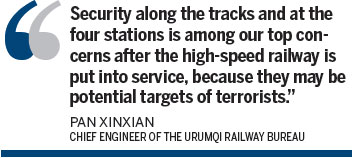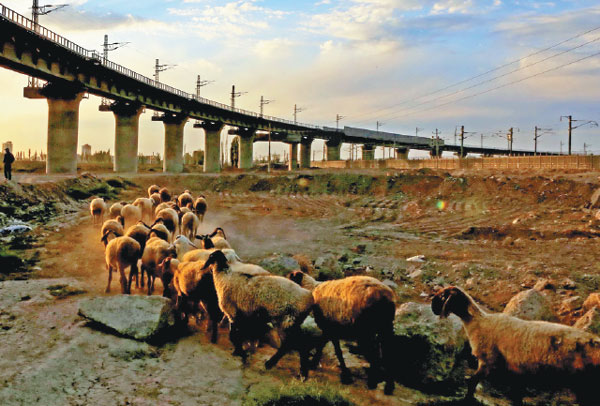New Xinjiang railway security tight
By Cui Jia in Urumqi (China Daily) Updated: 2014-11-06 07:55
|
In a contrast of traditional rural life and modern development, sheep walk near an overpass of the high-speed Lanzhou-Xinjiang Railway in Hami prefecture of the Xinjiang Uygur autonomous region in September. Cai Zengle / Xinhua |
Tough security measures will be adopted to prevent possible terrorist attacks on the Xinjiang Uygur autonomous region's first high-speed railway, which will go into service in Northwest China in 10 days, a local railway official said on Wednesday.
Connecting Urumqi, the capital of Xinjiang, and Hami, the 530-kilometer-long section of the Lanzhou-Xinjiang high-speed railway will begin service on Nov 16. It will be the first high-speed service in China's far west.
 "Security along the tracks and at the four stations is among our top concerns after the high-speed railway is put into service, because they may be potential targets of terrorists," said Pan Xinxian, chief engineer of the Urumqi Railway Bureau, which manages the region's rail links.
"Security along the tracks and at the four stations is among our top concerns after the high-speed railway is put into service, because they may be potential targets of terrorists," said Pan Xinxian, chief engineer of the Urumqi Railway Bureau, which manages the region's rail links.
Xinjiang has experienced an increasing number of terrorist attacks in recent years. The central government believes the penetration of religious extremism into the region, which has a large Muslim population, has led to the attacks.
On April 30, a group of terrorists set off explosives and slashed people with knives at the exit of the Urumqi South Railway Station, killing three people and injuring 79. A police investigation found that key members of the gang started to preach Islamic extremism in 2005.
 The high-speed railway is sealed off with fences that are higher than those along normal railway tracks. Also, all parts of the tracks are under 24-hour video surveillance, Pan said.
The high-speed railway is sealed off with fences that are higher than those along normal railway tracks. Also, all parts of the tracks are under 24-hour video surveillance, Pan said.
"We are also working on technology that will automatically alert railway staff workers if anyone attempts to climb over the fences to sabotage the track," he said.
Pan added that police officers from 22 areas along the railway will conduct routine patrols. Most of the line is located in the sparsely populated Gobi Desert.
The squares in front of the stations will be heavily guarded, and passengers will have to go through several security checks before boarding the train, Pan said.
The line, on which construction began in January 2010, is designed to support high-speed trains solely for transporting passengers at a top speed of 250 km/h.
Also, all passenger trains will be shifted to the new railsin the future, and the old line will serve freight trains only. That means the annual rail freight capacity to Xinjiang could surge to 200 million tons from the current 70 million tons, Ma Liangyuan, director of the transportation department of the regional development and reform commission, said on Wednesday.
"The increased freight capacity could significantly help to boost trade with neighboring countries and countries on the Silk Road Economic Belt, making Xinjiang a trade hub," Ma said.
When the new 1,776-km line is in full operation at the end of this year, it will reduce the travel time from Urumqi to Lanzhou, capital of Gansu province, by half - to about nine hours. People from Urumqi will be able to travel to Beijing by train in 16 hours instead of 40 after high-speed railways between the two cities are completed in 2017.
- Govt encourages people to work 4.5 days a week
- Action to be taken as HIV cases among students rise
- Debate grows over reproductive rights
- Country's first bishop ordained in 3 years
- China builds Tibetan Buddhism academy in Chengdu
- Authorities require reporting of HIV infections at schools
- Typhoon Soudelor kills 14 in East China
- Police crack down on overseas gambling site
- Debate over death penalty for child traffickers goes on
- Beijing to tighten mail security for war anniversary








